Lonnie Pacelli's Blog, page 49
August 30, 2019
Free 9/4-5: We Must Stop Meeting Like This! Meetings That Deliver Results
[image error] Free 9/4-5: We Must Stop Meeting Like This! Meetings That Deliver Results
Get it at https://amzn.to/2FxGwku
#freebook #teamwork #leadership #kindle #kindlefire #ebooks #ebook #Kindlefreebooks #Kindledeals #FREE #mustread #goodreads #greatreads #freebie #freebies #kindlebook #freebook #teamwork #leadership #meetings
Get it at https://amzn.to/2FxGwku
#freebook #teamwork #leadership #kindle #kindlefire #ebooks #ebook #Kindlefreebooks #Kindledeals #FREE #mustread #goodreads #greatreads #freebie #freebies #kindlebook #freebook #teamwork #leadership #meetings
Published on August 30, 2019 02:53
New job, now what? Create a practical 100-day plan to start your new gig on the right foot
So after you've celebrated that new job or promotion, the reality of what you've gotten into sets in. Now what? Where do I start? Who do I talk to? What are the most important things I need to address? Who can I impact if I do something wrong? Who can impact me if they do something wrong? The question list goes on, adding to the stress of taking the new job. Random execution not only translates to focusing on the wrong things, but also dramatically impacts your credibility with your manager, team, and stakeholders. The answer is not to arrogantly come into the job with all the answers, but to come in with a plan to understand the environment, draw conclusions on the most important things to focus on, and develop an execution plan to act on those conclusions. The answer is a 100-day plan.
First things first, your plan may not take exactly 100 days to complete. Depending on your situation it may take fewer days, or, if you are stepping into a major crisis, you may have to expedite the plan or do it concurrently with addressing the crisis. Generally speaking, your plan should not take more than 100 days to complete. The rationale is simple; you want to be viewed as someone who takes deliberate, thoughtful action, not someone who takes forever to figure out what needs to be done. If you can get it done faster and do quality work then by all means do so; just be deliberate in your action.
My 100-day plan focuses on six steps as shown in the graphic below, followed by more detail:Develop a 100-Day What/Who/When/Asks PlanIdentify Who Informs, Concurs, and DecidesUnderstand What Works, Is Broken, and Could Be BetterDevelop a What I Learned SummaryCreate a What Actions Do We Need To Take? ListDevelop an Execution What/Who/When/Asks Plan
Note: click on each graphic to see a larger, easier to read picture
 The 100-day plan's purpose is designed to help you do the following:Understand who the key stakeholders are in and around your organization and the roles they playIdentify what is working, not working, and could be working better in your area of responsibilitySummarize what needs to be done and when it needs to be done byCommunicate a clear execution plan of the most important things to focus on, who needs to do them, and when they need to be done by.Establish credibility with your manager, team, and other stakeholders as someone who listens and seeks to understand before taking action.
The 100-day plan's purpose is designed to help you do the following:Understand who the key stakeholders are in and around your organization and the roles they playIdentify what is working, not working, and could be working better in your area of responsibilitySummarize what needs to be done and when it needs to be done byCommunicate a clear execution plan of the most important things to focus on, who needs to do them, and when they need to be done by.Establish credibility with your manager, team, and other stakeholders as someone who listens and seeks to understand before taking action.
Following is an explanation of each of the six steps comprising the 100-day plan with an example of how the deliverable should look.
Step 1: Develop 100 Day What/ Who/ When/ Asks Plan
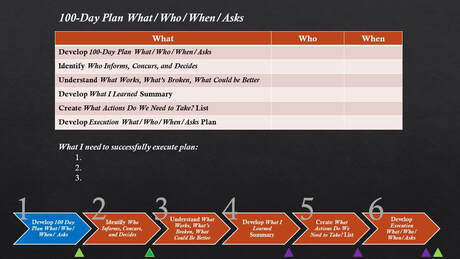 Step 1 is articulate your 100-day plan tasks, who will be performing those tasks, and when you anticipate the tasks being complete. Being "aggressively realistic" is important here; meaning you move the work forward as quickly as you reasonably can while ensuring a quality end product. Once you've determined the what, who, and when of your tasks, articulate any specific requests to your management to help you get the plan executed. Does your plan require travel which requires expense approval? Do you need your manager to provide an introductory email to some stakeholders informing them of your new position and that you'll be contacting them? Think through what those "asks" are then do a plan review with your manager for concurrence and approval. Step 2: Identify Who Informs, Concurs, and Decides
Step 1 is articulate your 100-day plan tasks, who will be performing those tasks, and when you anticipate the tasks being complete. Being "aggressively realistic" is important here; meaning you move the work forward as quickly as you reasonably can while ensuring a quality end product. Once you've determined the what, who, and when of your tasks, articulate any specific requests to your management to help you get the plan executed. Does your plan require travel which requires expense approval? Do you need your manager to provide an introductory email to some stakeholders informing them of your new position and that you'll be contacting them? Think through what those "asks" are then do a plan review with your manager for concurrence and approval. Step 2: Identify Who Informs, Concurs, and Decides
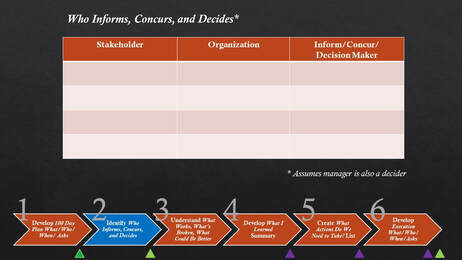 Step 2 is the development of an internal and external list of stakeholders who you want to interview as part of your current-state understanding. Internal stakeholders are those who are within your direct organization including direct reports, extended team members, and other people who impact or are impacted by the work your organization does. External stakeholders are those outside your organization who may or may not be impacted by your work but can provide good information on the current state. External stakeholders also can include experts outside of your company who provide information on industry trends, best practices, or other data points which could help give information about your future direction. For each stakeholder you should identify whether the stakeholder informs you (provides advice but is not directly impacted by your execution plan), concurs with you (doesn't formally approve your execution plan but you want/need their buy-in), or is a decision maker (formally approves your execution plan). I also think it's important to do a checkpoint with your manager as she/he may have additional stakeholders who are functionally or politically important to include, along with their appropriate inform/concur/decide status.
Step 2 is the development of an internal and external list of stakeholders who you want to interview as part of your current-state understanding. Internal stakeholders are those who are within your direct organization including direct reports, extended team members, and other people who impact or are impacted by the work your organization does. External stakeholders are those outside your organization who may or may not be impacted by your work but can provide good information on the current state. External stakeholders also can include experts outside of your company who provide information on industry trends, best practices, or other data points which could help give information about your future direction. For each stakeholder you should identify whether the stakeholder informs you (provides advice but is not directly impacted by your execution plan), concurs with you (doesn't formally approve your execution plan but you want/need their buy-in), or is a decision maker (formally approves your execution plan). I also think it's important to do a checkpoint with your manager as she/he may have additional stakeholders who are functionally or politically important to include, along with their appropriate inform/concur/decide status.
Step 3: Understand What Works, Is Broken, and Could Be Better
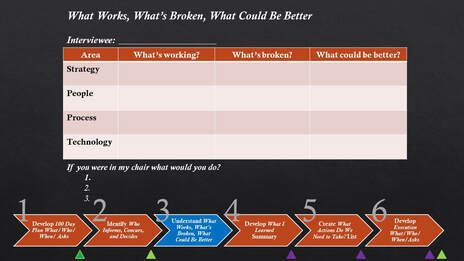 Step 3 is about interviewing your stakeholders to understand what is currently working, what's broken, and what might be working but could work better. This step is vital to not only understanding the current state but to establish a reputation with team members and stakeholders as someone who listens prior to taking action. I've found it helpful to focus on four areas in your works/broken/better discussion: organization strategy, people, processes, and technology. Depending on your situation these areas may be different. The last question I like to ask is, "If you were sitting in my chair, what are the top three things you would you do?" This is particularly effective not only in understanding items stakeholders think are important, but the priority they place on those things they identify. You may customize what you talk about depending on your stakeholder, but it's better to have a structure to work from then alter as needed, rather than totally winging it. Remember to interview your manager to understand his/her top priorities and perspectives. Step 4: Develop What I Learned Summary
Step 3 is about interviewing your stakeholders to understand what is currently working, what's broken, and what might be working but could work better. This step is vital to not only understanding the current state but to establish a reputation with team members and stakeholders as someone who listens prior to taking action. I've found it helpful to focus on four areas in your works/broken/better discussion: organization strategy, people, processes, and technology. Depending on your situation these areas may be different. The last question I like to ask is, "If you were sitting in my chair, what are the top three things you would you do?" This is particularly effective not only in understanding items stakeholders think are important, but the priority they place on those things they identify. You may customize what you talk about depending on your stakeholder, but it's better to have a structure to work from then alter as needed, rather than totally winging it. Remember to interview your manager to understand his/her top priorities and perspectives. Step 4: Develop What I Learned Summary
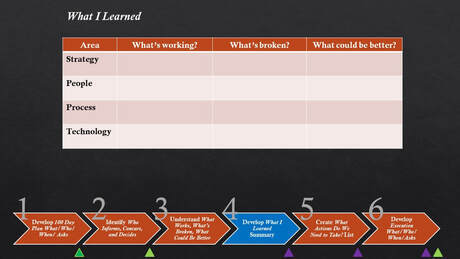 Step 4 is about taking what you've learned through your discussions and documenting trends and important facts that will influence execution plan actions. This is not an audit trail of everything you heard in every discussion; if you do that then you're likely to come out of the exercise with an unwieldy an non-actionable list. Conciseness and clarity are important here as this sets the stage for what you will focus on in your execution plan. You'll also want to do a checkpoint with your concur stakeholders to confirm you are focused on the right working/broken/better items and underscore that you've listened to what others have told you. Again, this is a crucial credibility builder with those you will be working with. Step 5: Create What Actions Do We Need to Take? List
Step 4 is about taking what you've learned through your discussions and documenting trends and important facts that will influence execution plan actions. This is not an audit trail of everything you heard in every discussion; if you do that then you're likely to come out of the exercise with an unwieldy an non-actionable list. Conciseness and clarity are important here as this sets the stage for what you will focus on in your execution plan. You'll also want to do a checkpoint with your concur stakeholders to confirm you are focused on the right working/broken/better items and underscore that you've listened to what others have told you. Again, this is a crucial credibility builder with those you will be working with. Step 5: Create What Actions Do We Need to Take? List
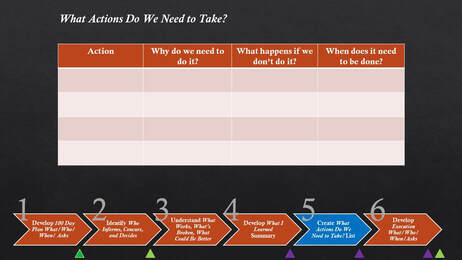 Step 5 begins the translation of what you've learned into what needs to be done to fix what's broken, improve upon what can be done better, and not disturb things that are working well. Each action includes three descriptive pieces of information: why it needs to be done, what the consequence if it isn't done, and when it needs to be done. Through articulating these factors you begin to develop a prioritized list of actions that comprise your execution plan. Do a checkpoint with your concur stakeholders prior to completing your execution plan. Step 6: Develop Execution What/ Who/ When/ Asks Plan
Step 5 begins the translation of what you've learned into what needs to be done to fix what's broken, improve upon what can be done better, and not disturb things that are working well. Each action includes three descriptive pieces of information: why it needs to be done, what the consequence if it isn't done, and when it needs to be done. Through articulating these factors you begin to develop a prioritized list of actions that comprise your execution plan. Do a checkpoint with your concur stakeholders prior to completing your execution plan. Step 6: Develop Execution What/ Who/ When/ Asks Plan
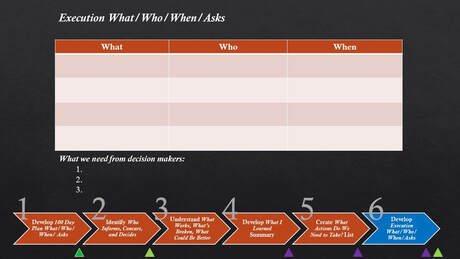 Step 6 is about taking the actions in step 5 and creating a what/who/when plan which facilitates you working on the most important actions and getting them done first. It's totally reasonable to divide your actions up into phases, with your first phase of actions having a more detailed plan and subsequent phases being done once the first phase is complete. I can't stress enough the importance of focusing on the most important items from step 5 first and not getting distracted with trying to plan out all of your actions. In this step you'll do a concur checkpoint to ensure their buy-in prior to doing a decision maker checkpoint. You want to make best efforts to secure concur stakeholder buy-in and avoid having dissenting stakeholders discredit your conclusions and plan.
Step 6 is about taking the actions in step 5 and creating a what/who/when plan which facilitates you working on the most important actions and getting them done first. It's totally reasonable to divide your actions up into phases, with your first phase of actions having a more detailed plan and subsequent phases being done once the first phase is complete. I can't stress enough the importance of focusing on the most important items from step 5 first and not getting distracted with trying to plan out all of your actions. In this step you'll do a concur checkpoint to ensure their buy-in prior to doing a decision maker checkpoint. You want to make best efforts to secure concur stakeholder buy-in and avoid having dissenting stakeholders discredit your conclusions and plan.
As mentioned throughout, your situation may require compression or expansion of the above steps. What doesn't change is the understand/conclude/act cycle that you'll need to go through to understand what you're getting into and determine what you need to address, while building trust and credibility with your stakeholders and management. Next time you take on a new job, use this model as a framework to help you execute a practical 100-day plan to get you off to a good start.
Want the PowerPoint slides used in this article? Email me.
Lonnie Pacelli
Keynote Speaker | Board Director | Autism Advocate | Author | Project Management Expert | Microsoft/Accenture Veteran
See his books on Amazon.
First things first, your plan may not take exactly 100 days to complete. Depending on your situation it may take fewer days, or, if you are stepping into a major crisis, you may have to expedite the plan or do it concurrently with addressing the crisis. Generally speaking, your plan should not take more than 100 days to complete. The rationale is simple; you want to be viewed as someone who takes deliberate, thoughtful action, not someone who takes forever to figure out what needs to be done. If you can get it done faster and do quality work then by all means do so; just be deliberate in your action.
My 100-day plan focuses on six steps as shown in the graphic below, followed by more detail:Develop a 100-Day What/Who/When/Asks PlanIdentify Who Informs, Concurs, and DecidesUnderstand What Works, Is Broken, and Could Be BetterDevelop a What I Learned SummaryCreate a What Actions Do We Need To Take? ListDevelop an Execution What/Who/When/Asks Plan
Note: click on each graphic to see a larger, easier to read picture
 The 100-day plan's purpose is designed to help you do the following:Understand who the key stakeholders are in and around your organization and the roles they playIdentify what is working, not working, and could be working better in your area of responsibilitySummarize what needs to be done and when it needs to be done byCommunicate a clear execution plan of the most important things to focus on, who needs to do them, and when they need to be done by.Establish credibility with your manager, team, and other stakeholders as someone who listens and seeks to understand before taking action.
The 100-day plan's purpose is designed to help you do the following:Understand who the key stakeholders are in and around your organization and the roles they playIdentify what is working, not working, and could be working better in your area of responsibilitySummarize what needs to be done and when it needs to be done byCommunicate a clear execution plan of the most important things to focus on, who needs to do them, and when they need to be done by.Establish credibility with your manager, team, and other stakeholders as someone who listens and seeks to understand before taking action.Following is an explanation of each of the six steps comprising the 100-day plan with an example of how the deliverable should look.
Step 1: Develop 100 Day What/ Who/ When/ Asks Plan
 Step 1 is articulate your 100-day plan tasks, who will be performing those tasks, and when you anticipate the tasks being complete. Being "aggressively realistic" is important here; meaning you move the work forward as quickly as you reasonably can while ensuring a quality end product. Once you've determined the what, who, and when of your tasks, articulate any specific requests to your management to help you get the plan executed. Does your plan require travel which requires expense approval? Do you need your manager to provide an introductory email to some stakeholders informing them of your new position and that you'll be contacting them? Think through what those "asks" are then do a plan review with your manager for concurrence and approval. Step 2: Identify Who Informs, Concurs, and Decides
Step 1 is articulate your 100-day plan tasks, who will be performing those tasks, and when you anticipate the tasks being complete. Being "aggressively realistic" is important here; meaning you move the work forward as quickly as you reasonably can while ensuring a quality end product. Once you've determined the what, who, and when of your tasks, articulate any specific requests to your management to help you get the plan executed. Does your plan require travel which requires expense approval? Do you need your manager to provide an introductory email to some stakeholders informing them of your new position and that you'll be contacting them? Think through what those "asks" are then do a plan review with your manager for concurrence and approval. Step 2: Identify Who Informs, Concurs, and Decides Step 2 is the development of an internal and external list of stakeholders who you want to interview as part of your current-state understanding. Internal stakeholders are those who are within your direct organization including direct reports, extended team members, and other people who impact or are impacted by the work your organization does. External stakeholders are those outside your organization who may or may not be impacted by your work but can provide good information on the current state. External stakeholders also can include experts outside of your company who provide information on industry trends, best practices, or other data points which could help give information about your future direction. For each stakeholder you should identify whether the stakeholder informs you (provides advice but is not directly impacted by your execution plan), concurs with you (doesn't formally approve your execution plan but you want/need their buy-in), or is a decision maker (formally approves your execution plan). I also think it's important to do a checkpoint with your manager as she/he may have additional stakeholders who are functionally or politically important to include, along with their appropriate inform/concur/decide status.
Step 2 is the development of an internal and external list of stakeholders who you want to interview as part of your current-state understanding. Internal stakeholders are those who are within your direct organization including direct reports, extended team members, and other people who impact or are impacted by the work your organization does. External stakeholders are those outside your organization who may or may not be impacted by your work but can provide good information on the current state. External stakeholders also can include experts outside of your company who provide information on industry trends, best practices, or other data points which could help give information about your future direction. For each stakeholder you should identify whether the stakeholder informs you (provides advice but is not directly impacted by your execution plan), concurs with you (doesn't formally approve your execution plan but you want/need their buy-in), or is a decision maker (formally approves your execution plan). I also think it's important to do a checkpoint with your manager as she/he may have additional stakeholders who are functionally or politically important to include, along with their appropriate inform/concur/decide status.Step 3: Understand What Works, Is Broken, and Could Be Better
 Step 3 is about interviewing your stakeholders to understand what is currently working, what's broken, and what might be working but could work better. This step is vital to not only understanding the current state but to establish a reputation with team members and stakeholders as someone who listens prior to taking action. I've found it helpful to focus on four areas in your works/broken/better discussion: organization strategy, people, processes, and technology. Depending on your situation these areas may be different. The last question I like to ask is, "If you were sitting in my chair, what are the top three things you would you do?" This is particularly effective not only in understanding items stakeholders think are important, but the priority they place on those things they identify. You may customize what you talk about depending on your stakeholder, but it's better to have a structure to work from then alter as needed, rather than totally winging it. Remember to interview your manager to understand his/her top priorities and perspectives. Step 4: Develop What I Learned Summary
Step 3 is about interviewing your stakeholders to understand what is currently working, what's broken, and what might be working but could work better. This step is vital to not only understanding the current state but to establish a reputation with team members and stakeholders as someone who listens prior to taking action. I've found it helpful to focus on four areas in your works/broken/better discussion: organization strategy, people, processes, and technology. Depending on your situation these areas may be different. The last question I like to ask is, "If you were sitting in my chair, what are the top three things you would you do?" This is particularly effective not only in understanding items stakeholders think are important, but the priority they place on those things they identify. You may customize what you talk about depending on your stakeholder, but it's better to have a structure to work from then alter as needed, rather than totally winging it. Remember to interview your manager to understand his/her top priorities and perspectives. Step 4: Develop What I Learned Summary Step 4 is about taking what you've learned through your discussions and documenting trends and important facts that will influence execution plan actions. This is not an audit trail of everything you heard in every discussion; if you do that then you're likely to come out of the exercise with an unwieldy an non-actionable list. Conciseness and clarity are important here as this sets the stage for what you will focus on in your execution plan. You'll also want to do a checkpoint with your concur stakeholders to confirm you are focused on the right working/broken/better items and underscore that you've listened to what others have told you. Again, this is a crucial credibility builder with those you will be working with. Step 5: Create What Actions Do We Need to Take? List
Step 4 is about taking what you've learned through your discussions and documenting trends and important facts that will influence execution plan actions. This is not an audit trail of everything you heard in every discussion; if you do that then you're likely to come out of the exercise with an unwieldy an non-actionable list. Conciseness and clarity are important here as this sets the stage for what you will focus on in your execution plan. You'll also want to do a checkpoint with your concur stakeholders to confirm you are focused on the right working/broken/better items and underscore that you've listened to what others have told you. Again, this is a crucial credibility builder with those you will be working with. Step 5: Create What Actions Do We Need to Take? List Step 5 begins the translation of what you've learned into what needs to be done to fix what's broken, improve upon what can be done better, and not disturb things that are working well. Each action includes three descriptive pieces of information: why it needs to be done, what the consequence if it isn't done, and when it needs to be done. Through articulating these factors you begin to develop a prioritized list of actions that comprise your execution plan. Do a checkpoint with your concur stakeholders prior to completing your execution plan. Step 6: Develop Execution What/ Who/ When/ Asks Plan
Step 5 begins the translation of what you've learned into what needs to be done to fix what's broken, improve upon what can be done better, and not disturb things that are working well. Each action includes three descriptive pieces of information: why it needs to be done, what the consequence if it isn't done, and when it needs to be done. Through articulating these factors you begin to develop a prioritized list of actions that comprise your execution plan. Do a checkpoint with your concur stakeholders prior to completing your execution plan. Step 6: Develop Execution What/ Who/ When/ Asks Plan Step 6 is about taking the actions in step 5 and creating a what/who/when plan which facilitates you working on the most important actions and getting them done first. It's totally reasonable to divide your actions up into phases, with your first phase of actions having a more detailed plan and subsequent phases being done once the first phase is complete. I can't stress enough the importance of focusing on the most important items from step 5 first and not getting distracted with trying to plan out all of your actions. In this step you'll do a concur checkpoint to ensure their buy-in prior to doing a decision maker checkpoint. You want to make best efforts to secure concur stakeholder buy-in and avoid having dissenting stakeholders discredit your conclusions and plan.
Step 6 is about taking the actions in step 5 and creating a what/who/when plan which facilitates you working on the most important actions and getting them done first. It's totally reasonable to divide your actions up into phases, with your first phase of actions having a more detailed plan and subsequent phases being done once the first phase is complete. I can't stress enough the importance of focusing on the most important items from step 5 first and not getting distracted with trying to plan out all of your actions. In this step you'll do a concur checkpoint to ensure their buy-in prior to doing a decision maker checkpoint. You want to make best efforts to secure concur stakeholder buy-in and avoid having dissenting stakeholders discredit your conclusions and plan.As mentioned throughout, your situation may require compression or expansion of the above steps. What doesn't change is the understand/conclude/act cycle that you'll need to go through to understand what you're getting into and determine what you need to address, while building trust and credibility with your stakeholders and management. Next time you take on a new job, use this model as a framework to help you execute a practical 100-day plan to get you off to a good start.
Want the PowerPoint slides used in this article? Email me.
Lonnie Pacelli
Keynote Speaker | Board Director | Autism Advocate | Author | Project Management Expert | Microsoft/Accenture Veteran
See his books on Amazon.
Published on August 30, 2019 02:53
August 26, 2019
I Wasn’t Expecting This! Five Tips for Mastering Expectation Alignment
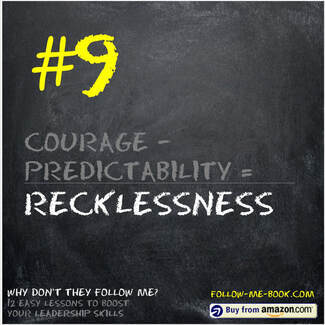 Some time back I was the executive sponsor responsible for developing a facility strategy for a new line of business. I empowered one of my project managers to develop the strategy which we would jointly present to our management. We both had visions of what we expected in the strategy but I didn’t ensure our points of view meshed.. My project manager was very competent in her job; however mind-reading was not one of her skills. The day before we were due to present the strategy, I did a walk-through with her. It wasn’t anything like I envisioned, and I knew the strategy in its current state wouldn’t be well received by our management. We went through a fire drill to get the strategy to a state where I thought it would be better received. We survived the review with our management, but it didn’t go nearly as well as it could have gone, and we went through a lot of pain (including a sleepless night) to rework the strategy.
Some time back I was the executive sponsor responsible for developing a facility strategy for a new line of business. I empowered one of my project managers to develop the strategy which we would jointly present to our management. We both had visions of what we expected in the strategy but I didn’t ensure our points of view meshed.. My project manager was very competent in her job; however mind-reading was not one of her skills. The day before we were due to present the strategy, I did a walk-through with her. It wasn’t anything like I envisioned, and I knew the strategy in its current state wouldn’t be well received by our management. We went through a fire drill to get the strategy to a state where I thought it would be better received. We survived the review with our management, but it didn’t go nearly as well as it could have gone, and we went through a lot of pain (including a sleepless night) to rework the strategy.I don’t fault the project manager one bit for the misstep. It was totally on me that the strategy wasn’t what I was thinking because I didn’t ensure our expectations were aligned at the outset. I also didn’t put checkpoints in place along the way to ensure we stayed aligned. It cost us not only in additional work but in relationship trust. I blew it.
My story unfortunately is just one of many I’ve seen and experienced through the years where expectations were misaligned. Due to my experiences I’ve become manic about setting and aligning expectations, so much so that when I get misaligned it’s like being punched in the gut. It’s at the leader’s feet to ensure clear expectation alignment when empowering someone to get something done. Those leaders who just expect someone to ask the right questions on the what, who and when of getting something done are just asking for frustration and rework. This is a “measure-twice-cut-once” application; a little extra work up front to ensure alignment can save a lot of downstream pain.
Need help to better define and stay aligned on expectations? Consider the following five tips:
Be crisp on the what, who and when – Expectation alignment starts with an intentional understanding of what needs to be done, who needs to do it, and when it needs to be done by. Be specific, including specific dates and named owners. Also take time to understand other’s expectations and drive getting to a common vision.Wireframe the deliverable – For a more complex deliverable it may be worthwhile to wireframe out what the deliverable needs to look like, whether it be a table of contents, a picture, or some other means that brings clarity to what “done” looks like.Take regular checkpoints – Develop an agreed-upon follow-up rhythm to ensure that deliverable progress is on track and any deviations can be caught early. See my article on Fostering a Follow-Up Culture for more.Outline clear actions if there is a deviation to the deliverable – It’s certainly possible for there to be a deviation to the deliverable whether it be content, date, or some other factor. Ensure clear agreement exists among stakeholders as to how changes will be communicated, what decisions the deliverable owner can make, and what requires agreement among the stakeholders.Articulate the consequences of misaligned expectations – When expectations do get misaligned, be clear on both the business impact and how stakeholders are impacted. For example, misaligned expectations may mean a date slip which might impact downstream activities. Being clear about the consequence helps keep everyone aligned on the importance of producing a timely desired result.
As leaders, it is your job to take the lead on clearly aligning expectations for delivery. In this “measure-twice-cut-once” approach, well defined expectation alignment means less execution friction. Your team needs it.
Lonnie Pacelli
Keynote Speaker | Board Director | Autism Advocate | Author | Project Management Expert | Microsoft/Accenture Veteran
See his books on Amazon.
Published on August 26, 2019 02:51
August 25, 2019
Free 8/28-29: The Team Didn't Gel!
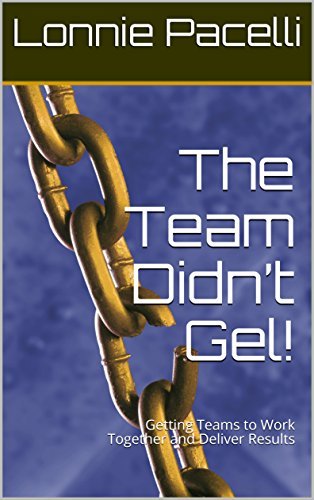 Free 8/28-29: The Team Didn't Gel!
Free 8/28-29: The Team Didn't Gel!Get it at https://amzn.to/2Kh8X4S
#freebook #teamwork #leadership #kindle #kindlefire #ebooks #ebook #Kindlefreebooks #Kindledeals #FREE #mustread #goodreads #greatreads #freebie #freebies #kindlebook #projectmanagement #leadership #PMI
Published on August 25, 2019 12:56
August 17, 2019
Free 8/21-22: The Perfect Brainstorm - Getting The Most Out Of Brainstorming Sessions
 Free 8/21-22: The Perfect Brainstorm - Getting The Most Out Of Brainstorming Sessions
Free 8/21-22: The Perfect Brainstorm - Getting The Most Out Of Brainstorming SessionsGet it at https://amzn.to/2zjXnSe
#freebook #teamwork #leadership #kindle #kindlefire #ebooks #ebook #Kindlefreebooks #Kindledeals #FREE #mustread #goodreads #greatreads #freebie #freebies #kindlebook #projectmanagement #leadership #PMI
Published on August 17, 2019 02:50
Get an entertaining and informative keynote with 12 leadership lessons from Why Don't They Follow Me?
Want an energetic and informative keynote to drive and expand followership in your organization? Lonnie's popular leadership book
Why Don't They Follow Me?
can be delivered in an engaging keynote that will give the audience impactful tips they can immediately apply to boost leadership skills and strengthen followership.
Leadership lessons delivered in the keynote include:Humor - Credibility = DoofusKnowledge – Listening = Arrogance
Action – Integrity = Distrust
Activity – Focus = Randomness
Wisdom – Experience = Theory
Ability – Effort = Inaction
Leadership – Inspiration = Administration
Charisma – Conviction = Crooked Politician
Courage – Predictability = Recklessness
Smarts – Direction = Absent Minded Professor
Communication – Candor = Storyteller
Decisiveness – Empathy = Ruthlessness
#element-fea2d88e-2fc1-40cb-91b4-d1f2e28184df .content-color-box-wrapper { padding: 20px; border-radius: 30px; background-color: #2a2a2a; border-style: Solid; border-color: #a1a1a1; border-width: 5px;}See Lonnie give a one-minute leadership lesson: Humor - Credibility = Doofus
#wsite-video-container-337494402506894288{ background: url(//www.weebly.com/uploads/b/19360013-584... } #video-iframe-337494402506894288{ background: url(//cdn2.editmysite.com/images/util/video... } #wsite-video-container-337494402506894288, #video-iframe-337494402506894288{ background-repeat: no-repeat; background-position:center; } @media only screen and (-webkit-min-device-pixel-ratio: 2), only screen and ( min-device-pixel-ratio: 2), only screen and ( min-resolution: 192dpi), only screen and ( min-resolution: 2dppx) { #video-iframe-337494402506894288{ background: url(//cdn2.editmysite.com/images/util/video... background-repeat: no-repeat; background-position:center; background-size: 70px 70px; } } Here's how it works:Lonnie holds a one-hour meeting with the sponsoring leader to understand current leadership pain points and how to best address them with the audience.Lonnie incorporates the pain points into his keynoteLonnie delivers a one-hour keynote discussing all 12 leadership lessons from Why Don't They Follow Me? including the pain points.
Interested? Let's connect to give your organization a memorable keynote to help them boost their leadership skills and strengthen followership.
Need to see more? Check out a sample chapter from Why Don't They Follow Me?
Leadership lessons delivered in the keynote include:Humor - Credibility = DoofusKnowledge – Listening = Arrogance
Action – Integrity = Distrust
Activity – Focus = Randomness
Wisdom – Experience = Theory
Ability – Effort = Inaction
Leadership – Inspiration = Administration
Charisma – Conviction = Crooked Politician
Courage – Predictability = Recklessness
Smarts – Direction = Absent Minded Professor
Communication – Candor = Storyteller
Decisiveness – Empathy = Ruthlessness
#element-fea2d88e-2fc1-40cb-91b4-d1f2e28184df .content-color-box-wrapper { padding: 20px; border-radius: 30px; background-color: #2a2a2a; border-style: Solid; border-color: #a1a1a1; border-width: 5px;}See Lonnie give a one-minute leadership lesson: Humor - Credibility = Doofus
#wsite-video-container-337494402506894288{ background: url(//www.weebly.com/uploads/b/19360013-584... } #video-iframe-337494402506894288{ background: url(//cdn2.editmysite.com/images/util/video... } #wsite-video-container-337494402506894288, #video-iframe-337494402506894288{ background-repeat: no-repeat; background-position:center; } @media only screen and (-webkit-min-device-pixel-ratio: 2), only screen and ( min-device-pixel-ratio: 2), only screen and ( min-resolution: 192dpi), only screen and ( min-resolution: 2dppx) { #video-iframe-337494402506894288{ background: url(//cdn2.editmysite.com/images/util/video... background-repeat: no-repeat; background-position:center; background-size: 70px 70px; } } Here's how it works:Lonnie holds a one-hour meeting with the sponsoring leader to understand current leadership pain points and how to best address them with the audience.Lonnie incorporates the pain points into his keynoteLonnie delivers a one-hour keynote discussing all 12 leadership lessons from Why Don't They Follow Me? including the pain points.
Interested? Let's connect to give your organization a memorable keynote to help them boost their leadership skills and strengthen followership.
Need to see more? Check out a sample chapter from Why Don't They Follow Me?
Published on August 17, 2019 02:50
Seven Tips to Fostering a Follow-Up Culture
 As a young manager I was on a particularly difficult assignment that had attention all the way up to the CEO of the company. The executive leading the project was a very seasoned and intentional leader who executed as well as anyone I’ve ever seen drive a crisis initiative. His ability to stay on top of the work was like nothing like I’d ever seen from other leaders in the organization. During my annual review with him, I asked what he saw as a crucial attribute of a successful leader. Without missing a beat, he gave me two words which continue to shape me as a leader: follow up.
As a young manager I was on a particularly difficult assignment that had attention all the way up to the CEO of the company. The executive leading the project was a very seasoned and intentional leader who executed as well as anyone I’ve ever seen drive a crisis initiative. His ability to stay on top of the work was like nothing like I’d ever seen from other leaders in the organization. During my annual review with him, I asked what he saw as a crucial attribute of a successful leader. Without missing a beat, he gave me two words which continue to shape me as a leader: follow up.Through the years I’ve seen how follow-up (or lack thereof) contributed to a team’s ability to successfully deliver results. Organizations that have follow-up in their DNA simply execute more friction-free than those who don’t. The leader stays better aligned with the work happening in the organization, and the followers better understand and execute to the leader’s expectations. I’ve seen it in my own experience as a leader. As my leadership skills matured and my follow-up ability became more autonomic, I saw first-hand how we were able to get things done more effectively. I also saw another benefit--my timely follow-up behavior reduced the number and magnitude of crises I had to deal with. I was more on top of what was happening, was better in sync with the team, and more engaged when the team needed my help to get something done.Fostering a follow-up culture isn’t difficult to do, it just takes discipline. Get the ball rolling by instituting these seven follow-up tips:Be known as a follow-up fiend – Simply put, when people know you follow up on commitments, they’re more likely to do what they agreed to. Be consistent and timely with follow-ups and do it every time. Followers know those leaders who follow up and those who don’t and are more likely to shirk responsibility if their leader’s follow-up is inconsistent or absent.Establish a follow-up cadence – In my article Intentional Empowerment I talk about the importance of a follow-up cadence when empowering someone to own solving a problem. A deliberate follow-up frequency is crucial to ensuring that you as the leader stay abreast of progress, as well as being available if your help is needed. Make sure you set an appropriate frequency, establish clear expectations on what will be done in each follow-up meeting, and that you live up to the follow-up commitment.Establish singular points of follow-up ownership – Follow-ups assigned to “the team” mean no one owns it and it’s less likely to get done. Ensure any follow-ups you give have a clear, singular owner who can be held accountable for delivery.Get them to summarize the what and when – At the end of a meeting if there are follow-up actions required, ask the accountable person to send you an email describing the follow-up action and when it will be done by. Asking them to do it better ensures an understanding and agreement as to the follow-up action and due date. After you get the email, copy it into your calendar on the follow-up due date for you to do then follow-up either in-person or by email.Acknowledge actions – Great follow-up leaders treat follow-up actions as important and followers want to feel their work wasn’t done in vain. When someone follows up on an action you requested, don’t just be silent. Even a quick “Thank you for following up” response tells your followers that their work was important enough for you to take the time to act upon it.Be real – If a follow-up was well-done, say so. If it wasn’t, say so. Creating a follow-up culture means you encourage good behavior and correct bad behavior. Be courageous and direct with both encouraging and correcting.Walk the talk – The best leaders who drive accountability through follow-up do what they say they’ll do when they say they’ll do it. They do it not only for their leaders but also for their followers. When followers can rely on their leader to live up to a commitment, it not only sets the example of follow-up, but also speaks volumes as to the leader’s integrity.There’s simply no reason not to establish and foster a follow-up culture. Just take the time to make it top-of-mind and instill the importance of it to your team.
Published on August 17, 2019 02:50
August 12, 2019
Strengthen Followership for You and Your Leadership Team with a "Why Don't They Follow Me?" Book Discussion
Want to drive and expand followership for you and your leadership team with a minimal time investment? Turn Lonnie's popular leadership book
Why Don't They Follow Me?
into a customized leadership team book discussion. Get relevant tips you and your team can immediately apply to boost leadership skills and strengthen followership.
Leadership lessons delivered in the keynote include:Humor - Credibility = DoofusKnowledge – Listening = ArroganceAction – Integrity = DistrustActivity – Focus = RandomnessWisdom – Experience = Theory Ability – Effort = InactionLeadership – Inspiration = AdministrationCharisma – Conviction = Crooked PoliticianCourage – Predictability = RecklessnessSmarts – Direction = Absent Minded ProfessorCommunication – Candor = StorytellerDecisiveness – Empathy = Ruthlessness
#element-19c922ab-3546-4530-81ce-5e97c52312de .content-color-box-wrapper { padding: 20px; border-radius: 20px; background-color: #2a2a2a; border-style: Solid; border-color: #818181; border-width: 5px;}See Lonnie give a one-minute leadership lesson: Humor - Credibility = Doofus
#wsite-video-container-169185295861396626{ background: url(//www.weebly.com/uploads/b/19360013-584... } #video-iframe-169185295861396626{ background: url(//cdn2.editmysite.com/images/util/video... } #wsite-video-container-169185295861396626, #video-iframe-169185295861396626{ background-repeat: no-repeat; background-position:center; } @media only screen and (-webkit-min-device-pixel-ratio: 2), only screen and ( min-device-pixel-ratio: 2), only screen and ( min-resolution: 192dpi), only screen and ( min-resolution: 2dppx) { #video-iframe-169185295861396626{ background: url(//cdn2.editmysite.com/images/util/video... background-repeat: no-repeat; background-position:center; background-size: 70px 70px; } } Here's how it works:The sponsoring leader reads the book (1 hour)The sponsoring leader and Lonnie meet to review each lesson and agree on relevant points to be made with the leadership team for each lesson (1 hour)The leadership team reads the book and completes a self-assessment prework assignment (2 hours)Lonnie discusses each lesson with the sponsoring leader and leadership team (either on-premise or virtual) to bring better understanding and relevance to each lesson (2 hours)Each leadership team member reviews their prework based on the discussion and develops a plan on what they will commit to work on over the next three months (1 hour)
Interested? Let's connect to help you and your leadership team boost those leadership skills and create an environment where followership thrives.
Need to see more? Check out a sample chapter from Why Don't They Follow Me?
Leadership lessons delivered in the keynote include:Humor - Credibility = DoofusKnowledge – Listening = ArroganceAction – Integrity = DistrustActivity – Focus = RandomnessWisdom – Experience = Theory Ability – Effort = InactionLeadership – Inspiration = AdministrationCharisma – Conviction = Crooked PoliticianCourage – Predictability = RecklessnessSmarts – Direction = Absent Minded ProfessorCommunication – Candor = StorytellerDecisiveness – Empathy = Ruthlessness
#element-19c922ab-3546-4530-81ce-5e97c52312de .content-color-box-wrapper { padding: 20px; border-radius: 20px; background-color: #2a2a2a; border-style: Solid; border-color: #818181; border-width: 5px;}See Lonnie give a one-minute leadership lesson: Humor - Credibility = Doofus
#wsite-video-container-169185295861396626{ background: url(//www.weebly.com/uploads/b/19360013-584... } #video-iframe-169185295861396626{ background: url(//cdn2.editmysite.com/images/util/video... } #wsite-video-container-169185295861396626, #video-iframe-169185295861396626{ background-repeat: no-repeat; background-position:center; } @media only screen and (-webkit-min-device-pixel-ratio: 2), only screen and ( min-device-pixel-ratio: 2), only screen and ( min-resolution: 192dpi), only screen and ( min-resolution: 2dppx) { #video-iframe-169185295861396626{ background: url(//cdn2.editmysite.com/images/util/video... background-repeat: no-repeat; background-position:center; background-size: 70px 70px; } } Here's how it works:The sponsoring leader reads the book (1 hour)The sponsoring leader and Lonnie meet to review each lesson and agree on relevant points to be made with the leadership team for each lesson (1 hour)The leadership team reads the book and completes a self-assessment prework assignment (2 hours)Lonnie discusses each lesson with the sponsoring leader and leadership team (either on-premise or virtual) to bring better understanding and relevance to each lesson (2 hours)Each leadership team member reviews their prework based on the discussion and develops a plan on what they will commit to work on over the next three months (1 hour)
Interested? Let's connect to help you and your leadership team boost those leadership skills and create an environment where followership thrives.
Need to see more? Check out a sample chapter from Why Don't They Follow Me?
Published on August 12, 2019 00:00
August 10, 2019
Strengthen Followership for You and Your Management Team with a "Why Don't They Follow Me?" Book Discussion
 Want to drive and expand followership for you and your management team with a minimal time investment? Turn Lonnie's popular leadership book
Why Don't They Follow Me?
into a customized leadership team book discussion. Get relevant tips you and your team can immediately apply to boost leadership skills and strengthen followership.
Want to drive and expand followership for you and your management team with a minimal time investment? Turn Lonnie's popular leadership book
Why Don't They Follow Me?
into a customized leadership team book discussion. Get relevant tips you and your team can immediately apply to boost leadership skills and strengthen followership.Here's how it works:The sponsoring leader reads the book (1 hour)The sponsoring leader and Lonnie meet to review each lesson and agree on relevant points to be made with the leadership team for each lesson (1 hour)The leadership team reads the book and completes a self-assessment prework assignment (2 hours)Lonnie discusses each lesson with the sponsoring leader and leadership team (either on-premise or virtual) to bring better understanding and relevance to each lesson (2 hours)Each leadership team member reviews their prework based on the discussion and develops a plan on what they will commit to work on over the next three months (1 hour)
Give the sample chapter a look then let's connect to help you and your team boost those leadership skills and create an environment where followership thrives.
Published on August 10, 2019 02:54
August 8, 2019
Free 8/14-15: The Leadership Made Simple Series
 Free 8/14-15: The Leadership Made Simple Series
Free 8/14-15: The Leadership Made Simple SeriesGet it at https://amzn.to/2TsHRfl
#freebook #teamwork #leadership #kindle #kindlefire #ebooks #ebook #Kindlefreebooks #Kindledeals #FREE #mustread #goodreads #greatreads #freebie #freebies #kindlebook #projectmanagement #leadership #PMI
Published on August 08, 2019 02:53



